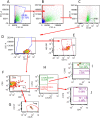Association of Ocular Surface Immune Cells With Dry Eye Signs and Symptoms in the Dry Eye Assessment and Management (DREAM) Study
- PMID: 37669063
- PMCID: PMC10484021
- DOI: 10.1167/iovs.64.12.7
Association of Ocular Surface Immune Cells With Dry Eye Signs and Symptoms in the Dry Eye Assessment and Management (DREAM) Study
Abstract
Purpose: Dry eye disease (DED) is a multifactorial, heterogeneous disease of the ocular surface with one etiology being ocular surface inflammation. Studies using animal models demonstrate the role of ocular surface immune cells in the inflammatory pathway leading to DED, but few have evaluated humans. This study described the white blood cell population from the ocular surface of patients with DED and assessed its association with DED signs and symptoms in participants of the Dry Eye Assessment and Management (DREAM) study.
Methods: Participants were assessed for symptoms using the Ocular Surface Disease Index, signs via corneal staining, conjunctival staining, tear break-up time, and Schirmer test, and Sjögren's syndrome (SS) based on the 2012 American College of Rheumatology classification criteria. Impression cytology of conjunctival cells from each eye was evaluated using flow cytometry: T cells, helper T cells (Th), regulatory T cells (Tregs), cytotoxic T cells, and dendritic cells.
Results: We assessed 1049 eyes from 527 participants. White blood cell subtype percentages varied widely across participants. Significant positive associations were found for Th and conjunctival staining (mean score of 2.8 for 0% Th and 3.1 for >4.0% Th; P = 0.007), and corneal staining (mean score of 3.5 for 0% Th and 4.3 for >4.0% Th; P = 0.01). SS was associated with higher percent of Tregs (median 0.1 vs. 0.0; P = 0.01).
Conclusions: Th were associated with more severe conjunctival and corneal staining, possibly indicating their role in inflammation leading to damage of the ocular surface. There is no consistent conclusion about Tregs in SS, but these results support that Tregs are elevated in SS.
Conflict of interest statement
Disclosure:
Figures




References
-
- Stapleton F, Alves M, Bunya VY, et al. .. TFOS DEWS II epidemiology report. Ocul Surf. 2017; 15: 334–365. - PubMed
-
- Farrand KF, Fridman M, Stillman IO, Schaumberg DA.. Prevalence of diagnosed dry eye disease in the United States among adults aged 18 years and older. Am J Ophthalmol. 2017; 182: 90–98. - PubMed
Publication types
MeSH terms
Grants and funding
LinkOut - more resources
Full Text Sources
Medical

